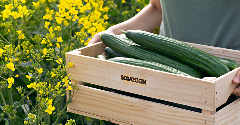News
DuPont introduces alternative to ascorbic acid
16 Oct 2018DuPont has introduced alternative to ascorbic acid for bakery products, claiming that DuPont Danisco GRINDAMYL SUREBake product range will enable bakers to produce cost effective, high-quality products.

DuPont has introduced alternative to ascorbic acid for bakery products, claiming that DuPont Danisco GRINDAMYL SUREBake product range will enable bakers to produce cost effective, high-quality products.
The rising costs of ascorbic acid is prompting many baking industry manufacturers to search for an alternative dough strengthener, DuPont believes, noting that regulatory measures on environmental compliance and control in China have caused price hikes on ascorbic acid to continue. This, the company says, poses significant challenges for bakeries to produce high-quality products while maintaining good profit margin. DuPont claims it is the only producer of hexose oxidase that is an alternative to ascorbic acid for bakery products. Unlike existing oxidative enzymes, the company says, the hexose oxidase technology present in the DuPont Danisco GRINDAMYL SUREBake product range can utilize many different sugar molecules as a substrate rather than just glucose alone. This, it says, helps improve the gluten network in dough systems through oxidization during mixing and fermentation, forming stronger bonds between the gluten, thereby giving a better production with a drier dough and thus no stickiness issue.“The price of ascorbic acid is still rising,” said Lee Lai See, Food Enzyme Business Director for ASPAC. “As many ASEAN manufacturers buy ascorbic acid from China, an increasing number of customers are switching to a GRINDAMYL SUREBake product fully or partially to buffer their cost. By using GRINDAMYL SUREBake, bakers will be able to reduce their production cost while maintaining the dough processability with improved baking performance such as better water absorption that result in bigger bread volumes.” According to DuPont, the GRINDAMYL SUREBake product range can be used in any process where flour requires an extra oxidative effect to create the desired properties and improvement of flours. The hexose oxidase is said to provide an excellent dough strengthening effect in the presence of oxygen and react with either mono- or disaccharides – unlike glucose oxidase, which is more dependent on flour variations and procedures. Hexose oxidase has a strong affinity for its substrates, which makes it a powerful biological oxidant.The strengthener can, DSM says, be used in various procedures and applications where a highly stable system is required. With the GRINDAMYL SUREBake product range, millers and bakers can expect to gain benefits in increased tolerance towards variations in processing parameters; reduced dough stickiness; increased water absorption; supplementation of chemical oxidants (including ascorbic acid, ADA etc); improved shape and dimensions of the final bread product; and increased bread volumeDuPont says that manufacturers who have used a GRINDAMYL SUREBake product have seen improved bread quality in various applications. The strengthener can also be used in various procedures where a highly stable system is required, such as frozen dough.Related news

Soy story: WWF scores UK supermarkets on sustainability efforts
12 Nov 2025
WWF has published its latest “Soy Scorecard”, ranking UK supermarkets’ efforts to combat deforestation and land conversion in their soy supply chains.
Read more
Standing Ovation and Bel scale up casein production from dairy co-products
11 Nov 2025
Foodtech company Standing Ovation has partnered with cheese specialist Bel Group to manufacture dairy serums for industrial-scale casein production via precision fermentation.
Read more
New UPF standard hoped to offer consumers ‘coherence and clarity’
10 Nov 2025
Ingredients companies are being urged to enter “a new era of partnership and innovation” following the launch of the industry’s first non-UPF verification scheme.
Read more
Whistleblowers accuse UK meat industry of promoting cheap, unsustainable supply
7 Nov 2025
An anonymous group of industry insiders has accused the UK’s biggest food companies of systematically driving down meat quality and welfare standards.
Read more
Bord Bia presents Irish dairy ingredient suppliers at Fi Europe
6 Nov 2025
Dairygold Co-operative Society, The Carbery Group, and Ornua Co-operative: Meet with sustainable producers of Irish dairy ingredients at Food ingredients Europe 2025, Hall 7.2 Stand M18.
Read more
AI attraction means foodtech startups must ‘prove’ rather than ‘promise’
4 Nov 2025
Reports suggest that artificial intelligence (AI) is sucking investment from foodtech and agritech, but investors say the picture is complicated.
Read more
Penguin and Club bars no longer classed as chocolate
30 Oct 2025
Penguin and Club bars can no longer be classified as chocolate after the pladis-owned McVitie’s brands turned to cheaper alternatives amid the ongoing cocoa crisis.
Read more
Could plant-based protection replace plastic packaging?
29 Oct 2025
Swedish foodtech company Saveggy has launched an additive-free plant-based protection for cucumbers, offering a waste-free packaging solution for fruit and vegetables.
Read more
Does promoting protein content push up plant-based sales?
27 Oct 2025
Promoting the protein content of meat-free products is a more effective sales strategy than adding carbon labels, a study of UK bakery chain Greggs suggests.
Read more
Amazon Grocery launch aims to balance quality with affordability
22 Oct 2025
Global e-commerce giant Amazon has introduced a new private-label food brand, combining existing Amazon Fresh and Happy Belly products with new everyday items.
Read more
